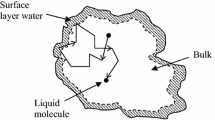Abstract
The1H nuclear magnetic spin relaxation of water in slurry of kaolin clay was investigated in the presence of magnetite (black iron oxide, Fe3O4) at 0.2 T and room temperature. The water spectra at high magnetite contents showed two different resonances, presumably from surface-associated water and free interstitial water. The difference in observed resonance frequencies increased as much as 200 ppm with increasing magnetite content. The apparent nuclear magnetic resonance intensity decreased biexponentially as a function of magnetite added. The observedT *2 values at low magnetite contents were in accordance with the predicted values from the resonance intensities and the estimated magnetic susceptibilities. TheT 1 relaxation was multiexponential in character, so a uniform penalty program was used for the analysis of distribution. At 0.2 T for1H, kaolin slurry containing less than 5.5 ppm magnetite did not differ significantly from magnetite-free clay in the longitudinal relaxation rates of water. However, higher concentrations of magnetite produced features in theT 1 distribution significantly different from those of magnetite-free clay. TheT 2 could be approximated by monoexponential relaxation, probably because the fast-decaying components relaxed before they could be recorded. The apparent transverse relaxation ratesR 2 increased linearly as a function of magnetite content. On the basis of the comparison of spin-echo and Carr-Purcell-Meiboom-Gill data, an empirical relation was derived to describe the signal loss due to diffusion. It can be expressed by a power function of magnetite amount, which is multiplied by the sum of volume-dependent and volume-independent terms.
Similar content being viewed by others
References
Flannery B.P., Deckman H.W., Roberge W.G., D’Amico K.L.: Science237, 1439–1443 (1987); Monteiro P.J., Pichot C., Belkebir K. in: Materials Science of Concrete (Skalny V.Y., Mindess S., eds.), pp. 537–572, Westerville: American Ceramic Society, 1998; Garboczi E.J.: Cem. Concr. Res.32, 1621–1638 (2002); Otani J., Yuzo O.: X-Ray CT for Geomaterials: Soils, Concrete, Rocks. London: Taylor & Francis 2004.
Teresa N., Randall E.W., Samoilenko A.A., Bodart P., Feio G.: J. Phys. D29, 805–808 (1996); Young J.J., Szomolanyi P., Bremner W.T., Balcom B.J.: Cem. Concr. Res.34, 1459–1466 (2004); Nestle N.: Solid State Nucl. Magn. Reson.25, 80–83 (2004)
Tanaka M., Nagashima K., Kamei T., Ando Y., Tujioka T.: J. Jpn. Soc. Civ. Eng.778, 173–181 (2004)
Bryar T.R., Daughney C.J., Knight R.J.: J. Magn. Reson.142 74–85 (2000)
Valckenborg R.M.E., Pel L., Kopinga K.: J. Magn. Reson.151, 291–297 (2001)
Haines W.B.: J. Agr. Sci.13, 296–310 (1923)
Pople J.A., Schneider W.G., Bernstein H.J.: High-Resolution Nuclear Magnetic Resonance. New York: McGraw-Hill 1959.
Poulis J.A., Massen C.H., Weijts A.G.L.M.: Proc. Phys. Soc.82, 611–613 (1963)
Hwang J.Y.: J. Miner. Mater. Charact. Eng.1, 131–140 (2002)
Horak D., Lednicky F., Petrovsky E., Kapicka A.: Macromol. Mater. Eng.289, 341–348 (2004)
Hopkins J.A., Wehrli F.W.: Magn. Reson. Med.37, 494–500 (1997)
Borgia G.C., Brown R.J.S., Fantazzini P.: J. Magn. Reson.132, 65–77 (1998); Fantazzini P., Brown R.J.S., Borgia G.C.: Magn. Reson. Imaging21, 227–234 (2003)
Coates G.R., Xiao L., Prammer M.G.: NMR Logging Principles and Applications, Houston: Halliburton Energy Services Publication, distributed by Gulf Publishing Company 1999.
Penumadu D., Dean J.: Can. Geotech. J.37, 393–405 (2000)
Carr H.Y., Purcell E.M.: Phys. Rev.94, 630–638 (1954)
de Swiet T.M., Sen P.N.: J. Chem. Phys.100, 5597–5604 (1994)
Mills R.: J. Phys. Chem.77, 685–689 (1973)
Hürlimann M.: J. Magn. Reson.131, 232–240 (1998)
Brownstein K.R., Tarr C.E.: J. Magn. Reson.26, 17–24 (1977); Brownstein K.R., Tarr C.E.: Phys. Rev. A19, 2446–2453 (1979)
Author information
Authors and Affiliations
Corresponding author
Rights and permissions
About this article
Cite this article
Nagashima, K. Influence of magnetic impurities on proton spin relaxation of water in clay. Appl. Magn. Reson. 30, 55–73 (2006). https://doi.org/10.1007/BF03166982
Received:
Revised:
Issue Date:
DOI: https://doi.org/10.1007/BF03166982




